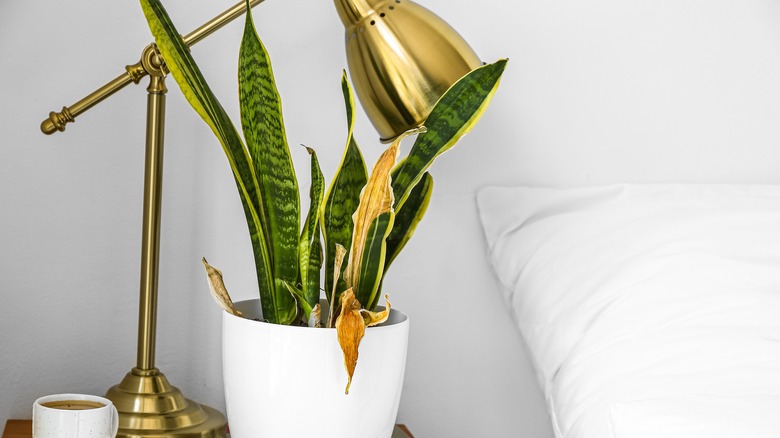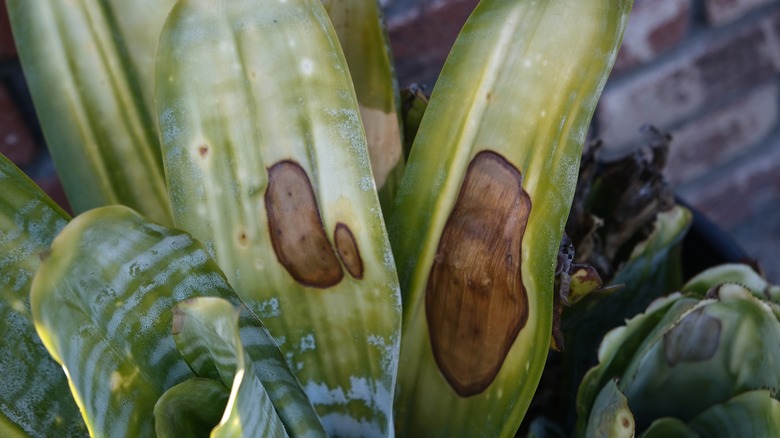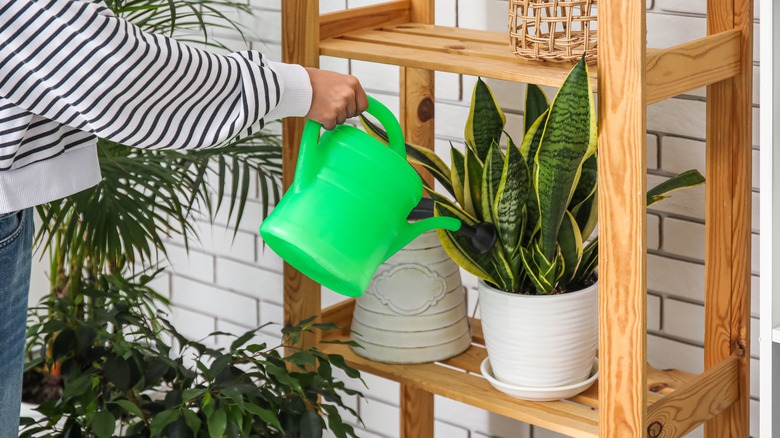Why Your Snake Plant Might Be Turning Brown (And What To Do About It)
Generally speaking, snake plants (Sansevieria trifasciata) are forgiving, easy-to-grow houseplants noted for their beautiful coloring and stripes. They are sure to bring some excitement into your space with their towering, sometimes spikey look. Though there are about 70 species of snake plants, most are a vibrant green color. That's why, if you start to see brown coloring on them, it may be time to take a closer look at the care you're providing.
Brown tips or edges on a snake plant indicate that it's not getting the right amount of watering or may be experiencing poor environmental surroundings that are stressing the plant. Sometimes, the problem relates to too much of a good thing (such as too much sunlight, water, or fertilizer). You may notice brown spots appearing, which could be an indication of a fungal disease. If you don't take action when you begin to see this browning, it could lead to the death of the plant. Though they tend to tolerate a significant amount of undesirable living conditions, the browning indicates the plant needs help. Typically, that means you'll need to remove the damaged areas and improve the environment to encourage health.
What is causing your snake plant to turn brown
Before you can take action to help the snake plant recover, consider what's causing the brown coloring to occur. One potential concern is overwatering or inconsistent watering. Typically, you shouldn't water this plant too often. Instead, wait until the dirt is nearly dried out and then water. Also, use water that's not too heavily chlorinated, and be sure to avoid pouring the water directly on the rosette (the leaf in the center of the plant), as that can create potential damage.
Next, consider the amount of sunlight present. Too much direct sunlight creates too much heat for the plant to tolerate, and that can cause browning leaves to occur. Snake plants do best in indirect light but can also be placed in low-light areas and still do well. If it's right in your bright sunny window on a hot day, this can lead to scorching of the leaves. At the same time, if the humidity is too low in that area or the temperature is cold, that can also damage the leaves. Another consideration is that you may be using too much fertilizer. Try to fertilize just once a month with a plant-based product at half-strength for the best overall support without overpowering the plant. Also note that if the brown color is only a few spots rather than the entire leaves or the leaf edges, that indicates a fungal disease that requires treatment. The use of topical fungicide may help.
How to treat brown leaves on a snake plant
If you're noticing that your snake plant has issues, there are several things you can do to fix it. First, as noted, determine what the problem is and then start there. Be sure the plant is getting the nutrients it needs, the right amount of fertilizer and sunlight, and the proper level of water. Fixing the problem first helps encourage the right environment for recovery. Then, prune the plant. There's no way to restore the health of brown leaves in most cases, but you can prune away the areas of damage to allow the plant to focus on the recovery. Be sure to use sharp pruning shears that are properly sanitized. Don't remove more than one or two leaves of a plant at one time, as that will cause damage to them. To cut leaves off of a snake plant, remove the damaged portion and cut at the base where the leaf meets the soil for more extensive, full-leaf removal needs.
Pruning the snake plant will remove the damage but also encourage new growth. Doing this regularly, even when there are no brown areas, can help ensure your plant consistently grows at a healthy rate. It will take some time for new growth to develop on most snake plants, especially if there are significant brown edges on the plant. Giving it the right environment will support the development of the plant.



